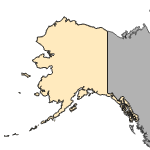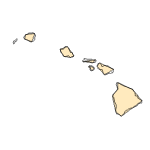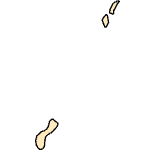Mieniplotia scabra
(Pagoda tiara)
Mollusks-Gastropods
Exotic |
|
Common name: Pagoda tiara
Synonyms and Other Names: Buccinum scabrum O.F. Müller, 1774; Thiara scabra (O.F. Müller, 1774)
Identification: Elongate conic shell is spinose with a high spire and a deep red striped pattern.
Size: 20 mm in shell height (Thompson et al., 2009)
Native Range: South and Southeast Asia and Indo-Australian Archipelago and western Pacific Islands (Brandt, 1974 as cited in Thompson et al., 2009).



|

Alaska |

Hawaii |

Puerto Rico &
Virgin Islands |

Guam Saipan |
Hydrologic Unit Codes (HUCs) Explained
Interactive maps: Point Distribution Maps
Nonindigenous Occurrences:
Table 1. States with nonindigenous occurrences, the earliest and latest observations in each state, and the tally and names of HUCs with observations†. Names and dates are hyperlinked to their relevant specimen records. The list of references for all nonindigenous occurrences of Mieniplotia scabra are found here.
Table last updated 1/13/2026
† Populations may not be currently present.
Ecology: This snail lives in freshwater streams (Maciolek and Ford, 1987) and coastal brackish waters (Sri-aroon et al., 2004). Reproduction is parthenogenic (Thompson et al., 2009). Embryos develop into a shelled juvenile in a brood pouch fed by a yolk sac and a placenta-like epithelium (Glaubrecht, 2006). They have few young, but are well developed when they hatch (Glaubrecht, 2006).
Means of Introduction: Because of its relatively small size and ornate shell, it may have been an aquarium trade introduction (Thompson et al., 2009).
Status: It was first discovered in the Palm Beach Canal on the east side of Lake Okeechobee in southern Florida in 2006 where it was initially believed to be established. However, no live snails were found there in 2008. Two other populations were found and reported as established in the Caloosahatchee River and a Fort Myers canal in 2018.
Impact of Introduction: Unknown, however, this species is susceptible, albeit at a low rate of 1.2 percent, to trematode infections in Thailand (Dechruksa et al., 2007).
References: (click for full references)
Brandt, R.A.M. 1974. The non-marine aquatic Mollusca of Thailand. Archiv für Molluskenkunde 105:1-423.
Dechruksa, W., D. Krailas, S. Ukong, W. Inkapatanakul, and T. Koonchornboon. 2007. Trematode infections of the freshwater snail family Thiaridae in the Khek River, Thailand. Southeast Asian Journal of Tropical Medicine and Public Health 38(6):1016-1028.
Glaubrecht, M. 2006. Independent evolution of reproductive modes in viviparous freshwater Cerithioidea (Gastropoda, Sorbeoconcha) - a brief review. Basteria Supplement 3:23-28.
Maciolek, J.A. and J.I. Ford. 1987. Macrofauna and environment of the Nanpil-Kiepw River, Ponape, Eastern Caroline Islands. Bulletin of Marine Science 41(2):623-632.
Sri-aroon, P., C. Lohachit, and M. Harada. 2004. Survey of brackish-water snails in eastern Thailand. Southeast Asian Journal of Tropical Medicine and Public Health 35(Suppl. 1):151-155. http://www.tm.mahidol.ac.th/seameo/2004-35-suppl-1/27-150.pdf.
Thompson, F.G., M.W. Heyn, and D.N. Campbell. 2009. Thiara scabra (O. F. Mueller, 1774): the introduction of another Asian freshwater snail into the United States. The Nautilus 123(1):21-22.
Author:
Benson, A.J.
Revision Date: 8/9/2019
Citation Information:
Benson, A.J., 2026, Mieniplotia scabra (O.F. Müller, 1774): U.S. Geological Survey, Nonindigenous Aquatic Species Database, Gainesville, FL, https://nas.er.usgs.gov/queries/FactSheet.aspx?SpeciesID=2644, Revision Date: 8/9/2019, Access Date: 1/13/2026
This information is preliminary or provisional and is subject to revision. It is being provided to meet the need for timely best science. The information has not received final approval by the U.S. Geological Survey (USGS) and is provided on the condition that neither the USGS nor the U.S. Government shall be held liable for any damages resulting from the authorized or unauthorized use of the information.